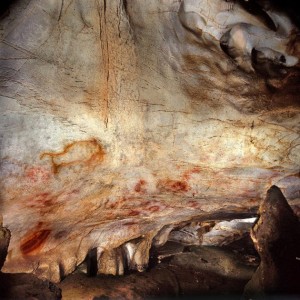
June 15, 2012


We don’t know as much as we think. We don’t even know who painted the cave paintings.
New tests show that crude Spanish cave paintings of a red sphere and handprints are the oldest in the world, so ancient they may not have been by modern man.
Some scientists say they might have even been made by the much-maligned Neanderthals, but others disagree.
Testing the coating of paintings in 11 Spanish caves, researchers found that one is at least 40,800 years old, which is at least 15,000 years older than previously thought. That makes them older than the more famous French cave paintings by thousands of years.
Scientists dated the Spanish cave paintings by measuring the decay of uranium atoms, instead of traditional carbon-dating, according to a report released Thursday by the journal Science. The paintings were first discovered in the 1870s.
The oldest of the paintings is a red sphere from a cave called El Castillo. About 25 outlined handprints in another cave are at least 37,300 years old. Slightly younger paintings include horses.
Cave paintings are “one of the most exquisite examples of human symbolic behavior,” said study co-author Joao Zilhao, an anthropologist at the University of Barcelona. “And that, that’s what makes us human.”
There is older sculpture and other portable art. Before the latest test, the oldest known cave paintings were those France’s Chauvet cave, considered between 32,000 and 37,000 years old.
What makes the dating of the Spanish cave paintings important is that it’s around the time when modern humans first came into Europe from Africa.
Study authors say they could have been from modern man decorating their new digs or they could have been the working of the long-time former tenant of Europe: the Neanderthal. Scientists said Neanderthals were in Europe from about 250,000 years ago until about 35,000 years ago. Modern humans arrived in Europe about 41,000 to 45,000 years ago — with some claims they moved in even earlier — and replaced Neanderthals.
“There is a strong chance that these results imply Neanderthal authorship,” Zilhao said. “But I will not say we have proven it because we haven’t.”
For complete article, see here.
About Loren Coleman
Loren Coleman is one of the world’s leading cryptozoologists, some say “the” leading living cryptozoologist. Certainly, he is acknowledged as the current living American researcher and writer who has most popularized cryptozoology in the late 20th and early 21st centuries.
Starting his fieldwork and investigations in 1960, after traveling and trekking extensively in pursuit of cryptozoological mysteries, Coleman began writing to share his experiences in 1969. An honorary member of Ivan T. Sanderson’s Society for the Investigation of the Unexplained in the 1970s, Coleman has been bestowed with similar honorary memberships of the North Idaho College Cryptozoology Club in 1983, and in subsequent years, that of the British Columbia Scientific Cryptozoology Club, CryptoSafari International, and other international organizations. He was also a Life Member and Benefactor of the International Society of Cryptozoology (now-defunct).
Loren Coleman’s daily blog, as a member of the Cryptomundo Team, served as an ongoing avenue of communication for the ever-growing body of cryptozoo news from 2005 through 2013. He returned as an infrequent contributor beginning Halloween week of 2015.
Coleman is the founder in 2003, and current director of the International Cryptozoology Museum in Portland, Maine.
Filed under Breaking News, CryptoZoo News, Forensic Science, Skeptical Discussions